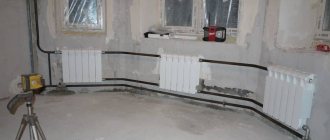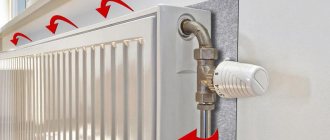The usable area of kitchens in old houses or modern small families often does not exceed 5-6 sq.m. Therefore, when purchasing household appliances, many people have doubts about their correct placement. Advice from experts will help you figure out how to place a refrigerator next to a heating radiator: is it possible or not, what should be the distance to heating devices, how to avoid overheating and damage to an expensive device.
General principles for placing household appliances in a small kitchen
Even if the unit is planned to be located in a small space, compliance with important rules must not be neglected:
- The room must be regularly ventilated and maintain normal humidity levels.
- The permissible distance between the top wall of the device and the ceiling is 10 cm.
- The appliance cannot be placed next to the stove; its side gets very hot, which can negatively affect the operation of the refrigerator. If you cannot move the unit to a safe distance, you need a thermal insulation partition. These requirements also apply to the oven.
- The unit cannot be placed near a window. When exposed to direct sunlight, the device heats up. To cool the chamber to the required level, the refrigerator begins to work more intensely, consuming a significant amount of electricity. If the load on the engine is prolonged, it may wear out too quickly and fail.
- The refrigerator is installed level or tilted back no more than 2 0C. In this case, the doors will close tightly.
- The unit should not come into contact with other household appliances, otherwise the air circulation will be disrupted. The minimum gap between two devices is 5 cm.
To save space, you can purchase a refrigerator that is built into the kitchen unit. For such a device, a cabinet of appropriate dimensions is usually made. If the set is already ready, you can select the unit to match its parameters.
The refrigerator next to the battery in close proximity is incorrect. A heat shield is required.
Manufacturers are against it!
First I studied the theory. It turned out that manufacturers producing different models of equipment agree on a categorical ban on the proximity of a cooling and heating device.
A radiator located near the refrigerator creates conditions that are not suitable for normal operation of the equipment.
- The wall (rear, side) and the motor of the refrigeration unit are subject to constant heating.
- To maintain the required temperature in the chambers, the device operates without the necessary breaks.
- Constant operation without stopping can cause the compressor to fail faster.
- The service life of the unit will be reduced, and energy consumption caused by increased work intensity, on the contrary, will increase.
Important! For refrigerators, it is undesirable to be in close proximity not only to the radiator, but also to other heat sources: stove, heater, fireplace, etc. The distance between them should be at least 35 cm. Optimally, a distance of 50 cm.
Consumers take risks
Manufacturers' recommendations are, of course, important. But let's be honest: we often deviate from them to a greater or lesser extent. And many people do the same when looking for space for a refrigerator. What happens? A discussion on the forum helps to find out about this.
If you believe the responses of the participants, they easily place cooling household appliances next to radiators, hot water pipes and gas stoves. Moreover, they are installed closely or at a minimum distance (about 5 cm).
Owners of the devices claim that such proximity does not affect their condition and operation. And to be convincing, they give the timing of such placement. And these are considerable numbers: 15–20 years.
Is it worth adding to the number of those who allow such combinations in their kitchen? Everyone makes their own decision. And he also takes responsibility for his decision. After all, no one can guarantee that your unit will work without breakdowns. And you certainly won’t have any complaints against the forum participants.
Well, what if this arrangement is the only convenient option?
Why not
Placing a household appliance in direct sunlight, as well as close to stoves, negatively affects its performance, as the compressor speeds up, starts working longer, consumes more electricity and increases wear. Often the small volumes of the kitchen leave no choice for the owners; they have to place the refrigerator next to other kitchen appliances. Of course, such an arrangement is unacceptable, but thanks to the availability of modern technologies, you can easily provide the refrigerator with reliable thermal insulation, which will protect the unit from overheating and normalize the heat transfer process.
What should be the distance from the refrigerator to the battery?
On average, you need to maintain a distance of 50 centimeters, but this does not take into account many factors. But you also need to take into account:
- Distance to ceiling and walls.
- Room ventilation.
- Dimensions.
- Capacitor position.
- The presence of partitions.
- The influence of other thermal appliances.
- Sunlight.
Each of these factors affects the minimum allowable distance. It is also worth considering the manufacturer and the specific model.
Important! Electricity consumption if placed incorrectly will be greater.
Nuances of remoteness
Without thinking whether it is possible to place a refrigerator next to a pipe or radiator and devices for distributing heat, a person places the refrigerator next to them. They may not always heat enough, but they work constantly during the heating season.
A brand new unit, next to which there is a radiator, may not even survive until the end of the warranty period.
Failure to maintain the minimum distance from the rear or side wall will result in poor air circulation along the cooling system location. If we add to this the unit’s system, which in its most advanced design can withstand +43 °C, hot summer time and cooking, you can say goodbye to the desired refrigerator, for which you have been saving money for a long time.
Heating radiator on the wall
And the last little secret - if the unit is standing at the wrong angle, its door opens with difficulty and does not slam shut spontaneously at the right time, and the open door interferes with movement around a small room - it means that the choice of place is wrong, even if all the previous conditions are met. Warm air will constantly flow into the slightly open refrigerator door, and this is a sure way to damage it, and in a short time.
Before you buy the coveted symbol of kitchen luxury, you need to choose a place where you can put it. There are no hopeless situations, and craftsmen or installers can easily solve the problem with the help of protective devices, sometimes very expensive ones. Are the efforts and resources worth the opportunity to squeeze a refrigerator next to a gas stove or radiator? You need to think carefully. Sometimes it is cheaper to simply purchase a smaller device.
Ventilation
Distance from battery to refrigerator
Where and at what distance you can place a refrigerator in a limited space is not an easy question and requires a thoughtful approach. Sometimes you can’t do without additional safety measures, even if you plan everything very carefully.
The task set for owners of a kitchen with a small area resembles a puzzle with a labyrinth, where there are prohibitory signs at every corner. After all, the purchased unit cannot be placed in direct sunlight or near heat sources, it cannot be left without the necessary air circulation, but it is also not recommended to place the refrigerator in a draft.
Kitchen in the house
Heating radiators, cooking stoves, other electrical appliances, ovens and hobs - all this is strictly contraindicated in a refrigerator in close proximity. If you can’t at all arrange the pieces of kitchen equipment so as to take into account all the features, you need to try to meet the conditions that allow you to install a battery-powered refrigerator at a small indentation:
- a household electrical appliance cannot be placed on the back wall of the heating device, and the side wall is also not recommended;
- the side wall or door of the refrigeration unit should be at a minimum distance of half a meter, and preferably not in a straight line, but horizontally (in small-sized kitchens of some projects this is possible in the corner near the window, however, in this case the end will be near the pipe, so it must be distanced by distance of at least 30 cm);
- it has been calculated that insufficient distance from the heating radiator, as a result of which the overall air temperature rises by approximately 5–6 °C, increases energy consumption by almost half, so the distance must be observed;
- The distance from the battery can only be reduced with sufficient air circulation or special protective devices.
Refrigerator dimensions
It should be taken into account
Problems with operating a refrigerator in the kitchen of a small apartment arise due to the inability to plan the space or soberly evaluate the purchased equipment. Considerations of prestige or reverence for brand names, as well as the desire to select household appliances based on a single color or design, lead to a common mistake.
This can be easily avoided if you carefully measure the intended installation location and purchase a refrigerator of suitable dimensions.
There are also important points - the class to which the purchase belongs (what temperature it can withstand), the location of the cooling system (it may not be located the same for different manufacturers, as a result of which the installation requirements will differ). These nuances affect the minimum distance from the refrigerator to the heating radiator (battery).
Well-established brands indicate the distance to certain household appliances that must be maintained. If you use minimal protective screens, the device can be placed near the hob or electric stove, removing it as far as possible from the battery.
Location standards
According to technical standards, the distance from various systems and walls to the refrigerator should be as follows:
- from the radiator or hot water pipe to any wall of the unit - 50 cm;
- from the side wall of the device to the battery – 30 cm;
- from the back wall to the heating device - 0 cm.
There is a complete ban on installing refrigeration equipment with a rear wall to heating systems. The same rules apply for the stove as for the battery.
Distance to system
Any side of the refrigeration equipment should be 50 cm away from the heating systems. This distance is enough to prevent the harmful effect of heat on the cooling unit.
If there is a heating pipe running under the floor of the house, or a “Warm Floor” system is installed in the home, a place for the refrigerator is chosen on the loggia, or a place for it is determined in advance before the renovation, where the heating will not be turned on at all.
How to extend the life of equipment
The question may arise: where should you put the refrigerator to extend its life? You need to think about this at the renovation stage. After all, moving it in the future will be problematic. It is necessary to prepare the outlet in advance and arrange the furniture accordingly.
You cannot place the refrigerator not only next to the radiator, but also near any heat sources. Including near the stove - it doesn’t matter whether it’s gas or electric. After all, when using it, the unit will also not be able to operate in normal mode. And if the heating, depending on the region, works from a couple of months to six months, or even more, then the stove is used daily throughout the year.
If the kitchen has a loggia, then it can be attached to the main room and the refrigerator can be placed there.
Also, you should not place the unit near a window, especially if the kitchen is on the sunny side. The sun heats its surface, so the motor works intensely most of the time. But if there is no other convenient place, then you need to hang very thick curtains that do not let in the sun's rays.
It is also important to ensure normal air circulation for the refrigerator. You need to know at what distance from the furniture it is advisable to place the equipment: it should be at least 5 cm. If this is not possible, at least a small gap should be left. In such cases, it is recommended to raise the unit higher above the floor surface by adjusting the legs accordingly. This measure will make it possible to compensate for small gaps on the sides.
Consequences of placing a refrigerator near a radiator
For normal operation of the unit, an influx of cold air is necessary, which the battery will be deprived of. Therefore, in order to maintain the set temperature in the chambers, he will have to work almost non-stop. This will make the electric meter spin faster and the refrigerator compressor wear out faster. It is likely that when the heating season ends, you will have to buy a new unit.
The most difficult situation occurs if the back wall of the refrigerator is installed close to the heating radiator. A condenser grille is placed on it, which instead of cooling will heat up.
This type of installation of a refrigerator is understandable if the owner wants to get rid of an annoying thing as quickly as possible, but it’s a pity to throw away a working unit.
If you place the refrigerator next to the radiator, sideways, then in this case, too, due to the warm air, ice will quickly form in the freezer. The freezer will have to be cleaned more often, and greens frozen in the refrigerator compartment will lose their smell and taste. Still, this is better than installing equipment with a compressor close to a hot battery.
Since some or all of the heating radiators will be closed, the room will become cooler, as the heat will go to heat the refrigerator and will be dissipated above. Having decided to place the refrigerator next to the battery, you should know that after this you will be denied warranty repairs because the conditions specified in the instructions have been violated.
Consequences of overheating refrigerator motor
Let's consider how such an unfriendly neighborhood can turn out when the refrigerator is located near the radiator? From the physics course we know that cold and heat should not interact. With the same success, in winter you can turn on the air conditioner for heating and open the windows wide open. The main disadvantage of such a neighborhood is overheating of the compressor. Freon circulates in the refrigerator circuits under pressure; it is necessary to cool the air inside the chamber, due to its transition from a liquid to a gaseous state. Freon is supplied to the condenser grille, due to which cooling occurs.
Negative consequences:
- Overheating of the electric motor of the refrigeration appliance, since the condenser grille will overheat instead of cooling, the freon temperature will change;
- Increased energy consumption as a result of constant operation of the device to maintain the set temperature;
- Reducing the service life of the refrigeration unit.
Attention: it is not recommended to place the electrical appliance next to any heating element - gas stove, electric stove and microwave oven.
An important point is that if the device breaks down as a result of being close to the battery, it cannot be repaired under the warranty card. The rules for operating the device specified in the instructions will be violated, and you will have to repair the refrigerator at your own expense.
Best answers
Alexander:
If a simple cold, i.e. with a capacitor on the outside (visible), then it is possible if it (cold) stands with its side wall facing the battery. In this case, it is enough to glue a layer of heat insulator, for example PENOFOL, onto the side wall facing the battery. It cannot be placed on the back side, because in this case, the compressor will overheat and turn off faster - you won’t get cold inside. If the refrigerator is “hidden”, i.e. and the condenser and evaporator are not visible, then in this case it is generally not recommended to place it near heating devices, because the capacitor in this case is located inside the side walls; There’s a compressor at the back, but there’s no way to put one in front...
Ches:
It’s not desirable, but I had one and it was okay, now there’s another one in the same place, a new one, but the old one has served its purpose, it’s 20 years old, although it’s still plowing!
Autobox:
– Are there rules for installing a refrigerator in the kitchen? Any instruction contains rules for installing the appliance. It is not recommended to install the refrigerator closer than five centimeters from walls and furniture and near heating appliances, for example, near radiators, because there is an additional flow of heat to the refrigerator. The motor-compressor turns off when a certain temperature is reached in the refrigerator or freezer compartment. It may happen that the heating device will influence the operating mode of the refrigerator so much that it will disrupt its normal operation, the refrigerator will work harder, and the food will cool worse. In modern refrigerators, which use special heat-insulating materials, such as polyurethane foam, the walls are reliably protected from external heat influx, so the question of the possibility of placing the refrigerator near heating devices can be ignored.
Evgeny Orekhov:
if you think like that, then both its hot engine and radiator grille should be installed at your neighbor’s
solomon101:
Can. And then change it every six months for a new one.
Ruslan:
If there is nowhere else, then between the battery and the back wall of the storage room you need to install a heat insulator-screen, for example, foam plymer with foil.
Ruslan Kharchenko:
Modern refrigerators are not afraid of batteries, feel free to install them!
Sergey:
possible but not advisable
Alexander:
depending on what battery and what kind of refrigerator.
Refrigerator Installation Methods
Before purchasing a useful kitchen unit, you should find out whether it is possible to place the refrigerator next to the radiator on its side or back wall. Its performance depends on the correct location of the device.
In large kitchens, this unit is installed in a kitchen cabinet system. The device is separated from the stove or battery by several meters. In a small kitchen, the refrigerator is isolated from heating appliances in different ways.
It is important to know! “Wherever you decide to place the refrigerator, it should be installed at a distance of 5 cm from the wall or any other surface. This rule applies to both the back wall and the side panels.”
The exception is those devices in which the fan and compressor are located at the bottom. They can be installed flush against walls and cabinets.
Distance between refrigerator and battery
Air circulation is one of the most important aspects in the operation of a refrigerator if it is installed in a thermal accessibility zone. There should be a distance from the ceiling to the device of at least 30 cm, from the wall to the back of the case - 5 - 10 centimeters. The distance from the floor covering to the bottom of the equipment is at least 4 cm, and between the wall and the heating device is about 40 cm. Exactly the same distance must be maintained between the equipment and the radiator.
Even if a partition is used, the distance between objects must be maintained. The legs of the refrigerator can be adjusted in height, you can conveniently adjust the position of the unit if the floor is uneven, adjust the gap between the bottom and the floor so that there is an air cushion and air can pass through. If there are heating pipes near the installation site, it is recommended to insulate it using a special permissible material.
Basic moments
Before purchasing a refrigerator, you should consider delivery issues - hire a vehicle of the appropriate size, measure the elevator doors, entrance and kitchen door openings so that the unit can be brought into the room without any problems. If you transport the device by placing it on the door or back wall, the compressor may come off and the freon may not flow properly, which can cause an air bubble to form and the system’s tightness may be compromised.
In winter, the distance of the device to the wall should be about 5 cm.
The most important installation rules:
- you need to place the refrigerator away from the sun and drafts, but where there is sufficient movement of air masses;
- in winter, the distance from the wall to the back wall of the unit is about five centimeters, in the summer it is moved back another three to five;
- the further the refrigerator is placed from any heating devices, the better, but it is not advisable to place it exactly opposite a gas, electric stove, heating radiator, etc.;
- Items such as a washing machine, any other electrical appliances (coffee maker, microwave oven, toaster, etc.) must not be installed in close proximity to the item;
- the refrigerating cabinet is placed at the same distance from various pieces of kitchen furniture;
- You should not connect the refrigerator through an extension cord or tee - it is permissible only through a stationary outlet.
Other household appliances are not allowed to be installed close to the refrigerator.
What to do if there is no other way out
However, in compact rooms it may be necessary to install refrigeration equipment near the radiator. In this case, experts advise what to do to maintain safe operation:
- The back wall of the equipment should not be adjacent to the radiator. It is optimal to place the unit with its side wall near the battery. You can move the device so that it overlaps the heatsink halfway to reduce the likelihood of overheating and failure.
- It is optimal to place the refrigerator in the kitchen at a distance of at least 50 cm from the heating system.
- A partition made of foil must be placed between the radiator and the cooling wall of the equipment. The element will help reflect heat and reduce the likelihood of the unit overheating.
- It is prohibited to place equipment close to the battery. The electric motor will not withstand prolonged exposure to the heating system and will be damaged. A broken engine cannot be repaired under warranty, because... such failure does not apply to such cases.
Way out
If the only possible place in the kitchen is next to the heating system, care should be taken to protect the appliance and extend its service life. There are several points that must be followed in order for the device to stand next to the battery:
- Under no circumstances should the back wall be placed close to the heat source;
- It is desirable that the battery occupies only part of the side wall for the normal functioning of the electrical appliance;
- Make a partition or screen, place foil on top, and place it between the radiator and the refrigerator. This method will help insulate the heat. You can use self-adhesive penofol on the side wall of the electrical appliance. Foil serves to reflect heat flows, penofol serves to absorb heat.
Correct location
When installing equipment, you need to know what distance should be from the refrigerator to the battery. You can determine what distance should be from a household appliance to heating systems using the following standards:
- From the battery or pipeline system with hot water to the walls of the refrigeration device, maintain at least 50 cm.
- The equipment is placed so that its side wall is at least 30 cm from the battery.
- The refrigerator should not be installed with its back wall facing heating appliances or an electric stove.
- The device can only be placed near an electric stove or oven if there is a partition with a heat-insulating layer.
- You need to know how far the refrigerator should be from the window. If placed close, direct sunlight will fall on the equipment, overheating its elements. The household device will spend more electricity on cooling, which will lead to its breakdown.
- Experts recommend adjusting the air flow at the bottom of the refrigerator. To do this, you will need to tighten the legs of the device to a height sufficient for safe operation or make stands.
- The floor surface must be level for stable operation of the cooling system of household appliances.
- When a heating pipe is placed under the floor or a “warm floor” system is installed, the refrigerator is moved to the loggia. It is optimal to determine the location for the unit before carrying out repair work and not plan floor heating in this area.
- For long-term operation of a household device, it is important to consider the following requirements:
- the room must be ventilated regularly to maintain stable humidity characteristics;
- the permitted distance from the refrigeration unit to the ceiling is 10 cm for safe use;
- the device must be placed level or tilted back no more than 2° (in this case, the doors will be closed hermetically).
Possible alternatives
The layout of many apartments includes a storage room. The owners use it for various purposes, for example, to store pickles and marinades, or as a warehouse for things that are rarely used. However, a pantry can be a great place to install a refrigerator.
Not everyone is ready to consider this option, as it creates certain inconveniences, such as the distance of the device from the kitchen. But in a case where convenience and keeping the unit in working order are in the balance, it makes sense to think about a similar placement option that can protect the device from negative influences.
A loggia can also be a good option for placing a refrigerator. Most often in a modern layout it is adjacent to the kitchen, which is certainly very convenient. The main condition in this case is the heating of the room and its glazing.
Also, in small apartments, owners place a refrigerator in the hallway, where there is often free space. In this case, the unit is located in close proximity to the kitchen, which is a very convenient factor. You can also install a refrigerator in the living room, but not everyone will appreciate this idea, preferring to leave the interior of this room free of kitchen appliances.
To learn how to build a refrigerator into a kitchen cabinet with your own hands, see the following video.
Alternative options
If there is no suitable space in the kitchen, you can choose an alternative installation option to extend the life of the technical device and free up space.
The list includes the following options:
- Placing the device in the pantry will save space in the kitchen. There is no air overheating in this room, because supplies and things are stored. The shelf life of the refrigeration unit can be extended. There should be an electrical outlet in the pantry or next to this room.
- A glazed loggia or balcony is a comfortable option for installing a refrigerator. The most convenient loggia is the one adjacent to the kitchen. However, it is important to consider that the room must be heated.
- In small apartments, you can move the household unit into a spacious corridor or hallway. You can allocate space in the closet for a compact refrigerator. The advantage is the close location of the kitchen, stable low air temperature.
- In some cases, it is recommended to place the device in the dining area; there is good air circulation in the room; the equipment will work for a long time.
Is it possible to install the equipment with the back facing the heating?
Installation with the back side facing the radiator is the most dangerous and unsuccessful. The grille of the appliance, whose main function is cooling, will heat up. The compressor will quickly break down, and buying a new one will be very expensive.
With this placement of the device, the radiator will be completely closed. The room will not receive the necessary heat. The air temperature will become much cooler due to the fact that the heat will be used to heat the equipment.
The only feasible solution is to relocate the radiator itself.
Important nuances when planning a kitchen
In order to create a comfortable environment in the kitchen, design experts advise using the win-win “triangle” rule. All kitchen equipment should be installed in 3 corners of the room; the most suitable option is to connect a gas stove, a dishwasher and refrigeration equipment.
This placement of all elements is the most successful. In addition to safety, it creates a comfortable space for work. In this way, you can create an overall comfortable multifunctional complex, which is equipped with the necessary work surfaces, cabinets, and shelves.
Opinion of owners of small kitchens
Many owners of small apartments have encountered the problem of properly installing a refrigerator. In a small kitchen there is not always free space, and the only available option is near the radiator. In order not to expose the unit to excessive overheating, the owners try to make a partition from heat-insulating material. Thus, they protect the device from premature failure.
The opinion of owners is not always clear: some believe that a refrigerator has a place in the kitchen, while others believe that it can be placed in another room. Typically, residents prefer the hallway or hall because they are in close proximity to the kitchen. Occasionally, the refrigerator is installed in a pantry, where the ideal temperature is always maintained, and the unit is not affected by thermal radiation.
How can I fix the situation?
The ideal arrangement of kitchen equipment is achievable if you have a large space, which not everyone has yet. It is difficult or impossible to achieve compliance with the triangle rule - so that the stove, refrigerator and radiator are located in three different corners, and between them there are tables, sofas and cabinets in a tiny kitchen.
Taking the unit into a narrow corridor or placing it in a living room is also not an option. This will cause a lot of inconvenience and will also disturb those who are light sleepers. The housewife, who will have to run far for the necessary products, will also not be delighted with this idea.
People get out of the situation by installing an additional hood on top of the refrigerator, making a duct into the air conditioning system, putting a rattan or polymer cover on the battery, which prevents the spread of heat and increased load on the motor.
A protective box or foil screen installed between the electrical appliance and the heat source helps.
In the most critical cases, a mini-stove or a sink for smaller dishes is purchased. But the ban on installation near a radiator has too strong grounds for it to be ignored. The cost of a new motor and its installation can cost half the price of a refrigerator, and the first thing that suffers when adjacent to the radiator is its engine.
Where should you not place a refrigerator in the kitchen?
In addition to locating the refrigeration unit near a heat source, it is not recommended to install it near a water supply. Water entering an electrical appliance may cause a short circuit. You should not place it too far, the main thing is to maintain a distance of 60 cm.
The option of locating the refrigeration unit near a window is also extremely undesirable. Exposure to direct sunlight also has a negative effect. The surface of the refrigerator overheats, and if the refrigerator’s thermal insulation is insufficient, heat from the heated surface is transferred into the chamber, which leads to continuous operation of the compressor.
Do not neglect the rules for operating an electrical appliance. Sometimes consumers trust messages on the forum that an electrical appliance lasts 5 years close to the battery and works like a clock without a single breakdown or thermal insulation. All cases are individual. Taking into account such messages, you must understand that the responsibility lies only with you. And only you have to pay for increased electricity costs or repairs of the unit.
It should be remembered that for some devices the thermal insulation of the chambers is far from ideal, and the warmer the air, the worse it performs its functions. In other words, the closer the refrigerator is to the heating source, the more heat will enter the refrigerator chamber. This will increase its operating time and increase energy consumption.
Food spoilage
Such “swings” are not in vain for the internal microclimate of the refrigerator chamber. There is no stability of cooling, you understand, therefore, there is no way to maintain an even temperature.
And as a result, sometimes the food will simply freeze. This is especially bad for fresh vegetables, fruits, and herbs. After a bunch of parsley is covered with a thin crust of ice, the smell will almost disappear and there will be almost no taste left.
Also, red caviar really doesn’t “like” freezing. It tastes completely different and becomes deformed.
Of course, this will not happen right away, but after a couple of years of operation of the equipment in a similar mode. And further! The freezer will also become covered with ice. And you will have to clean it much more often than under normal conditions.
Useful tips
First of all, you should think about purchasing a built-in model. Such a refrigerator can even be placed close to the battery if there are no other options. But this method is suitable only for those who are just planning to order furniture and will be able to choose the right size for themselves.
It is also advisable to defrost the refrigerator at least once a month. This will help reduce the load on the capacitor, making it last longer. If the device is located next to a radiator, then defrosting should be done twice as often.
Also make sure that the door closes completely, otherwise there will be more load on the condenser. And the smaller it is, the better for the refrigerator. For the same reason, the door cannot be kept open for long.
It is important to follow the instructions written by the manufacturer. Each device has its own requirements. It is generally undesirable to place some models in the kitchen. All the necessary information will be written in the instructions or passport.











